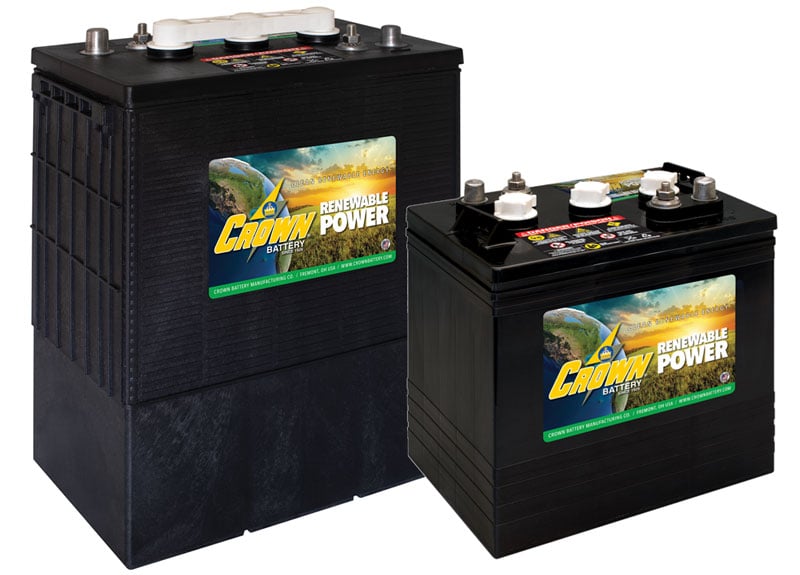Absorbed glass mat (AGM) batteries are popular for their reliability, value, sustainability, and safety.
AGM batteries offer near-zero maintenance because of their design. They never need watering, can be positioned on their side, work well in low temperatures, and are vibration-resistant.
But like all batteries – including Lithium-ion (LI) and Lithium-iron phosphate (LiFePO4) –, AGM batteries require a bit of care to maximize lifespan and reliability… along with proper charging.
In this blog post, you’ll discover:
- Simple tricks that minimize battery maintenance from Day 1
- Where to put AGM batteries for longer life and less work
- Charging basics that save you hassles and money
- Battery Maintenance 101
- And more
Minimize AGM maintenance up-front
When you select the right battery, maintenance will be easier and quicker for the rest of its lifespan.
“Starter or deep cycle?”
For most applications, there are two battery types. Pick the right one to avoid early replacement, downtime, and a host of other problems:
- Starter batteries are designed for three purposes: to deliver short bursts of engine starting power; to deliver backup power when a vehicle’s alternator cannot supply its total power demand; and, to absorb potential overcharge. They are not designed for continuous discharge service.
- Deep-cycle batteries are engineered to deliver power over extended periods – for instance, to operate electric vehicles, always-on electronics, or homes.
To learn more about the differences between starter and deep cycle batteries, read Cranking Battery vs. Deep Cycle Marine Battery (the advice applies to all batteries).
Simple tips can save maintenance time and minimize early failure:
- Check with your battery distributor or manufacturer to ensure you use properly sized wiring. This minimizes voltage drop and enhances safety.
- Never mix different battery sizes/capacities – or batteries of different ages. This can accelerate battery wear and reduce reliability.
- Fully charge batteries before the first use.
- Always charge AGM batteries whenever possible. Deep or prolonged discharging leads to sulfation and shortens battery life.
- Be sure the positive and negative battery terminals never touch; otherwise, this could result in a fire or explosion.
- Protect batteries from heat and cold as much as possible. Store stationary batteries (such as for renewable energy systems) in insulated, ventilated boxes – ideally where temperatures are mild. Electric vehicle (golf cart, forklift, etc.) and boat batteries do best when batteries/vehicles are stored indoors when not in use.
- If electric vehicle batteries are stored or used infrequently, charge them fully and then disconnect them from the equipment to minimize battery drain. Check batteries periodically and charge them if their charge level drops below 70%.
Get charging right
Charging is critical to minimize AGM battery maintenance and maximize life. Follow these guidelines:
- Always charge batteries in a well-ventilated area.
- For industrial applications, create a charging schedule and written instructions for connecting and disconnecting the cable from the charger. Post them on a wall next to the charging station.
- Be sure your charger is compatible with AGM batteries, which have less internal resistance – and thus recharge faster than flooded lead-acid models. Excessive voltage leads to overheating and could pop an AGM battery’s safety valve. Normally, safety valves release harmless gasses created during charging, ensuring proper internal pressure. If the safety valve pops, an AGM battery’s airtight seal is broken – and it will dry out and fail.
- Consider a smart, three-phase charger that’s customizable for your manufacturer’s recommended charging profile. This ensures the charge shifts to float mode once the battery is completely charged. Sensing battery temperature and voltage prevents overcharging – and overheating.
- Ensure your charger is properly sized and compatible with AGMs.
- Select a charger that compensates for temperature when setting voltage… or consult your battery and charger manuals for advice on adjusting this setting.
Monitor your batteries to catch problems early
Battery Management Systems (BMS) are real-time health monitors for your batteries.
Using a dedicated computer and sensors, BMS conducts real-time analysis of data from the battery's chemical processes and sends the information to you. In some cases, it can even modify charging and discharging settings. BMS system sensors can track vital parameters like battery voltage, state of charge level (SOC), health status (SOH), and ambient and battery temperatures. Some systems can even estimate charging duration.
BMS enhances durability, dependability, safety, and efficiency. It can also reduce maintenance and replacement costs by avoiding damaging conditions and providing early warning for problems.
Don’t discharge batteries too deeply
Depth of discharge (DOD) measures how much of a battery’s stored energy is used (discharged).
Recommended DOD for AGM batteries varies by application but is typically 50% (aka 50% of charge remains).
This maximizes the number of cycles you get during the battery’s life. And the easiest way to ensure you don’t use too much of a battery’s stored energy (i.e., exceed recommended DOD) is to size batteries properly. Your local distributor, installer, or Crown Battery rep can help you.
Critical steps for battery maintenance
Before physically inspecting batteries:
- Put on personal protective equipment (PPE) per manufacturer recommendations. This typically includes safety glasses or a face shield, rubber gloves, and a long-sleeved shirt that covers the arms.
- Remove any metallic objects you’re wearing, such as rings, earrings, necklaces, keys, or electronics.
- Be sure you have the correct tools on hand, including a cleaning brush, digital voltmeter, and insulated tools such as a screwdriver and wrench.
- Have distilled water and baking soda on hand for cleaning.
While physically inspecting batteries:
- Test every battery; even if just one performs poorly, it will cause others to fail early.
- Check the case for cracks, leaks, or damage. Battery terminals should be intact, not scratched or stripped.
- Ensure cables are intact, not frayed, split, worn, or otherwise damaged.
- Tighten connections and cables. This is critical for all batteries because weak connections waste energy and strain batteries. (Corroded or loose terminals prevent proper electrical flow.) If any connections are unsealed, coat them with dielectric grease.
- Clean terminals with a baking soda and water mixture. Remove corrosion with a wire brush. (Corrosion, dirt, and grease prevent current from flowing properly.) Then, rinse the battery or terminal with clean water. Dry completely.
- Repeat – set a calendar reminder to inspect batteries at the interval your manufacturer recommends.
What’s next?
For an in-depth guide to battery maintenance, including how to perform critical open-circuit voltage and load tests, get your free copy of our Safety First guide now. It’ll save you time and money, and keep your batteries running longer.











